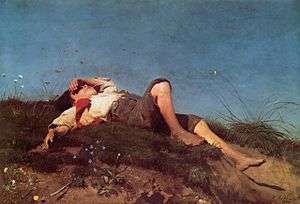Franz von Lenbach
.jpg)

Franz von Lenbach (13 December 1836 – 6 May 1904) was a German painter of Realist style. He travelled to Italy and Spain and completed many notable portraits.
Biography
Lenbach was born at Schrobenhausen, in Bavaria. His father was a mason, and the boy was destined for the building trade. He went to school at Landsberg, and then to the polytechnic at Augsburg. However, after seeing Hofner, the animal painter, executing some studies, he made various attempts at painting, which his father's orders interrupted. However, when he had seen the galleries of Augsburg and Munich, he obtained his father's permission to work for a short time in the studio of Gräfle, the painter; after this he devoted much time to copying.[1]
Lenbach was already accomplished when he became the pupil of Piloty, with whom he set out for Italy in 1858. A few works remain as the outcome of this first journey A Peasant seeking Shelter from Bad Weather (1855), The Goatherd (1860, in the Schack Gallery, Munich) and The Arch of Titus (in the Palfy collection, Budapest). On returning to Munich, he was at once called to Weimar to take the appointment of professor at the Academy. But he did not need to teach for long, having made the acquaintance of Count Schack, who commissioned a great number of copies for his collection.[1]
Lenbach returned to Italy the same year, and there copied many famous pictures.At this time he took on Ernst Friedrich von Liphart who was the gifted son of a Baltic German noble.[2] He set out in 1867 for Spain with Liphart, where he copied not only the famous pictures by Velázquez in the Prado, but also some landscapes in the museums of Granada and the Alhambra (1868).[1] This trip was funded by Lenbach's patron Count Schack.[3]
In the previous year he had exhibited at the great exhibition at Paris several portraits, one of which took a third-class medal. In 1882 Lenbach was ennobled, and since then known as von Lenbach. Thereafter he exhibited frequently both at Munich and at Vienna, and in 1900 at the Paris exhibition was awarded a Grand Prix for painting. Lenbach, who died in 1904, painted many of the most remarkable personages of his time[1]
Legacy
Most of von Lenbach's paintings are in National collections in the United Kingdom, with some in the Frye Art Museum in Seattle, Washington.[4] The UK collections include portraits by him of both Bismarck and Gladstone in the National Galleries of Scotland and there is another of Gladstone in the Palaces of Westminster.[5]
See also
References
| Wikimedia Commons has media related to Franz von Lenbach. |
- 1 2 3 4
 This article incorporates text from a publication now in the public domain: Chisholm, Hugh, ed. (1911). "Lenbach, Franz von". Encyclopædia Britannica (11th ed.). Cambridge University Press.
This article incorporates text from a publication now in the public domain: Chisholm, Hugh, ed. (1911). "Lenbach, Franz von". Encyclopædia Britannica (11th ed.). Cambridge University Press. - ↑ Baron Ernst Friedrich von Liphart, RusArtNet.com, retrieved 31 December 2013
- ↑ Ernst Friederich von Liphart, Master Paintings, retrieved 3 January 2014
- ↑ Charles and Emma Frye Collection, Frye Museum, retrieved 5 February 2014
- ↑ Paintings by Franz von Lenbach at the Art UK site
External links
- German masters of the nineteenth century: paintings and drawings from the Federal Republic of Germany, a full text exhibition catalog from The Metropolitan Museum of Art, which contains material on Franz von Lenbach (no. 44-49)